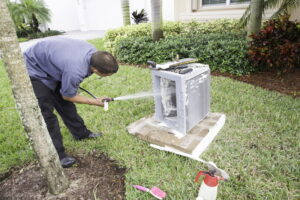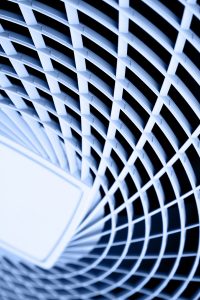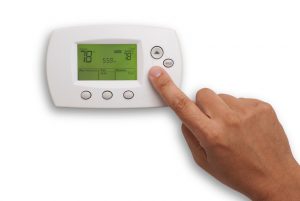 A piece of machinery that’s covered with a layer of grime and dirt won’t run as well as when it’s clean. That’s just a basic fact. When it comes to your air conditioning system, a layer of dirt and grime almost anywhere on it is bad news. For example, dust along the indoor evaporator coils can quickly cause the AC to lose energy efficiency and ice to develop along the coils.
A piece of machinery that’s covered with a layer of grime and dirt won’t run as well as when it’s clean. That’s just a basic fact. When it comes to your air conditioning system, a layer of dirt and grime almost anywhere on it is bad news. For example, dust along the indoor evaporator coils can quickly cause the AC to lose energy efficiency and ice to develop along the coils.
But you may not have considered dirt and debris on or around the outdoor cabinet (the condenser) as a problem. The condenser is located in a place on your property where it doesn’t attract much attention, since it’s not the most attractive piece of machinery. Many condensers are placed behind fences or barriers for this reason. And because the condenser is outdoors, it’s easy to think that it’s impervious to elements, and if it gets dirty or leaves or branches grow close to it, it’s not that big a deal.
But a dirty or obstructed condenser cabinet is a problem. If you’ve noticed trouble with your AC at this late part of the season and don’t know why, check the condenser. If it’s covered in dirt or obstructed in some way, this may be why you’re having AC issues.
Continue Reading
Tags: Air Conditioning Maintenance, Colorado Springs
Posted in Air Conditioning | Comments Off on Why It’s Important to Keep the Outdoor AC Cabinet Clean and Clear
 If you’ve lived in Colorado Springs through at least one winter season, you know that the arrival of March is no guarantee that the weather will just keep getting warmer as we move into spring. Nonetheless, it is the right time to think about your air conditioning system. You may not need to run the AC for a while yet, but now is when you should start getting it prepared.
If you’ve lived in Colorado Springs through at least one winter season, you know that the arrival of March is no guarantee that the weather will just keep getting warmer as we move into spring. Nonetheless, it is the right time to think about your air conditioning system. You may not need to run the AC for a while yet, but now is when you should start getting it prepared. 
 This week is the official start of fall. Temperatures, of course, don’t strictly obey the calendar, and you may still need to rely on running your air conditioner for a few more weeks. But it’s a transition time, and this is an ideal point in the year to stop and consider how well your air conditioner performed over the summer. This can help you make a few important decisions about your HVAC system and home comfort—in particular, answer the big question: “Is my AC good for another year, or should I schedule a replacement?”
This week is the official start of fall. Temperatures, of course, don’t strictly obey the calendar, and you may still need to rely on running your air conditioner for a few more weeks. But it’s a transition time, and this is an ideal point in the year to stop and consider how well your air conditioner performed over the summer. This can help you make a few important decisions about your HVAC system and home comfort—in particular, answer the big question: “Is my AC good for another year, or should I schedule a replacement?” A piece of machinery that’s covered with a layer of grime and dirt won’t run as well as when it’s clean. That’s just a basic fact. When it comes to your air conditioning system, a layer of dirt and grime almost anywhere on it is bad news. For example, dust along the indoor evaporator coils can quickly cause the AC to lose energy efficiency and ice to develop along the coils.
A piece of machinery that’s covered with a layer of grime and dirt won’t run as well as when it’s clean. That’s just a basic fact. When it comes to your air conditioning system, a layer of dirt and grime almost anywhere on it is bad news. For example, dust along the indoor evaporator coils can quickly cause the AC to lose energy efficiency and ice to develop along the coils. The indoor fan for your central air conditioning system is not only how the AC sends cooled air around the house. It’s also how the AC moves warm air brought from the living spaces across the evaporator coils to cool it down. Without a working fan, you have no cool air and no way to deliver any air to the rooms.
The indoor fan for your central air conditioning system is not only how the AC sends cooled air around the house. It’s also how the AC moves warm air brought from the living spaces across the evaporator coils to cool it down. Without a working fan, you have no cool air and no way to deliver any air to the rooms. The second half of summer is when you are more likely to encounter a malfunction with your air conditioning system. This makes sense, as the AC has been hard at work for at least a few months, and wear on the system can cause small problems to start to worsen. (Another reminder about why spring air conditioning maintenance is so vital.)
The second half of summer is when you are more likely to encounter a malfunction with your air conditioning system. This makes sense, as the AC has been hard at work for at least a few months, and wear on the system can cause small problems to start to worsen. (Another reminder about why spring air conditioning maintenance is so vital.) During stressful times, you don’t want to have yet another major problem dropped into your schedule. A broken air conditioning system counts for most people as a “major problem” during the summer, and if you have an air conditioner that isn’t providing the level of comfort your household requires, you will probably need to call us for
During stressful times, you don’t want to have yet another major problem dropped into your schedule. A broken air conditioning system counts for most people as a “major problem” during the summer, and if you have an air conditioner that isn’t providing the level of comfort your household requires, you will probably need to call us for  You’re probably not an expert at the technology of air conditioning systems. We don’t expect you to be—it’s a large field and it takes years of training to handle the extensive work involved in AC repair, installation, and other service work. We understand if you look at the stats on an air conditioner and feel a little bewildered. For example, what does a “5 Ton 15 SEER/11 EER R-410A refrigerant unit with a scroll compressor” mean?
You’re probably not an expert at the technology of air conditioning systems. We don’t expect you to be—it’s a large field and it takes years of training to handle the extensive work involved in AC repair, installation, and other service work. We understand if you look at the stats on an air conditioner and feel a little bewildered. For example, what does a “5 Ton 15 SEER/11 EER R-410A refrigerant unit with a scroll compressor” mean? The thermostat is how you communicate with your heating and cooling system. A simple idea on the surface. But handling thermostat settings requires a bit more planning and thought than just “raise it when it’s cold, lower it when it’s hot.” The thermostat doesn’t work like a throttle, and when it’s treated like one, it leads to energy waste, an uncomfortable house, and a potentially broken air conditioner during the summer.
The thermostat is how you communicate with your heating and cooling system. A simple idea on the surface. But handling thermostat settings requires a bit more planning and thought than just “raise it when it’s cold, lower it when it’s hot.” The thermostat doesn’t work like a throttle, and when it’s treated like one, it leads to energy waste, an uncomfortable house, and a potentially broken air conditioner during the summer. To ensure you have
To ensure you have  New homes are built with efficiency in mind, and for home builders, this means sealing them up as tightly as possible. Sure, this does wonders for your heating and cooling efficiency, however, it can seriously impact your indoor air quality, as tight sealing can seriously limit the amount of natural ventilation in the house. For this reason, it is important that homeowners have the proper ventilation systems in place, specifically heat recovery and energy recovery ventilators.
New homes are built with efficiency in mind, and for home builders, this means sealing them up as tightly as possible. Sure, this does wonders for your heating and cooling efficiency, however, it can seriously impact your indoor air quality, as tight sealing can seriously limit the amount of natural ventilation in the house. For this reason, it is important that homeowners have the proper ventilation systems in place, specifically heat recovery and energy recovery ventilators.